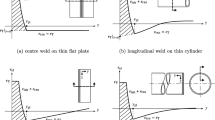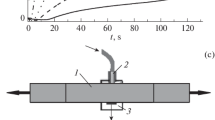Abstract
The temperature field and mode I stress intensity caused by resistance heating are calculated for a model problem. The results indicate that, for a constant far-field electric current, the stress intensity is proportional to the crack length to the power 5/2. Consequently, the effect of localized heating becomes especially important as the crack length increases and may, if ignored, cause significant errors during the more severe thermal fatigue tests that utilize direct resistance heating.
Résumé
On calcule pour un problème de modélisation le champ de température et l'intensité de contrainte de Mode I provoqué par un chauffage par résistance. Les résultats indiquent que, pour un courant électrique constant appliqué, l'intensité de contraintes est proportionnelle à la longueur d'une fissure à la puissance 5/2.
En conséquence, l'effet d'un chauffage local devient spécialement important lorsqu'on augmente la longueur de fissure, et peut, s'il est ignoré, induire des erreurs graves au cours d'essais de fatigue thermique de sévérité accrue qui recourent au chauffage direct par effect Joule.
Similar content being viewed by others
References
D.A. Wilson and J.R. Warren, 30th International Gas Turbine Conference and Exhibit, ASME Transactions, Paper no. 85-GT-12, (Houston, TX) March 18–21, 1985.
H.H. Johnson, Materials Research and Standards 5 (1965) 442–445.
G. Clark and J.F. Knott, Journal of the Mechanics and Physics of Solids 23 (1975) 215–216.
R.O. Ritchie and K.J. Bathe, International Journal of Fracture 15 (1979) 47–56.
M.A. Hicks and A.C. Pickard, International Journal of Fracture 20 (1982) 91–101.
M. Saka and H. Abe, International Journal of Engineering Science 21 (1983) 1451–1457.
R.M.J. Kemp, International Journal of Fracture 30 (1986) R33-R36.
A.L. Florence and J.N. Goodier, Journal of Applied Mechanics 27 (1960) 635–639.
A.L. Florence and J.N. Goodier, International Journal of Engineering Science 1 (1963) 533–540.
J.N. Goodier and A.L. Florence in Applied Mechanics, Proceedings of the 11th International Congress of Applied Mechanics, Munich 1964, Springer-Verlag (1966) 562–568.
G.C. Sih, Journal of Applied Mechanics 29 (1962) 587–589.
M.N. Bapu Rao, International Journal of Fracture 12 (1976) RCR 777–779.
Y. Konishi and A. Atsumi, International Journal of Engineering Science 11 (1973) 1–7.
H. Sekine, Engineering Fracture Mechanics 9 (1977) 499–507.
H. Sekine, Journal of Applied Mechanics 44 (1977) 637–642.
J. Tweed and S. Lowe, International Journal of Engineering Science 17 (1979) 357–363.
Y.E. Pak and G. Herrmann, ‘Energy Release Rates for Various Defects Disturbing a Uniform Heat Flow’, to be published.
Y.E. Pak and G. Herrmann, ‘Crack Extension Force in a Dielectric Medium’, submitted to International Journal of Engineering Science.
G.R. Doelp, J.F. Abel and F.C. Moon, ‘Experimental and Numerical Analysis of Electric Currents and Electromagnetic Blunting of Cracks in Thin Plates’, Report 84–12, Department of Structural Engineering, Cornell University, Ithaca, NY (1984).
Y.C. Fung, Foundations of Solid Mechanics, Prentice-Hall, Inc., Englewood Cliffs, New Jersey (1965).
G.B. Sinclair, International Journal of Fracture 28 (1985) 3–16.
S.E. Cunningham, ‘An Estimate of the Thermoelastic Stress Field Induced by an Electric Current Flowing Around a Crack’, Report SM 85–16, Department of Mechanical Engineering, Carnegie-Mellon University, Pittsburgh (1985).
F.B. Hildebrand, Advanced Calculus for Applications, Prentice-Hall, Inc., Englewood Cliffs, New Jersey (1976).
J.R. Warren, private communication, April 1985.
S.L. Hoyt (ed.), Metals Properties, ASME Handbook, McGraw-Hill Book Co., Inc. (1954) 371–383.
Monel, Inconel, Nickel and Nickel Alloys, International Nickel Co., Inc. (1947) 14–17.
H.C. Cross and W.F. Simmons, in Symposium on Materials for Gas Turbines, 49th Annual Meeting, ASTM, Buffalo, NY (1947) 3–51.
D.W. Grobecker (ed.) in Metals for Supersonic Aircraft and Missiles, Proceedings of the Conference, Heat Tolerant Metals for Aerodynamic Applications, ASM, Albuquerque, NM (1958) 234–249.
American Society for Metals, Source Book on Industrial Alloy and Engineering Data (1978) 311–337.
Author information
Authors and Affiliations
Rights and permissions
About this article
Cite this article
Cunningham, S.E., Griffin, J.H. & Sinclair, G.B. On stress intensities induced by direct resistance heating. Int J Fract 33, 135–144 (1987). https://doi.org/10.1007/BF00033745
Received:
Accepted:
Issue Date:
DOI: https://doi.org/10.1007/BF00033745




